Glycolic Acid: The Skincare Marvel
Glycolic acid is a type of alpha hydroxy acid (AHA) derived from sugarcane. Known for its small molecular size, it effectively penetrates the skin, making it a popular ingredient in skincare products. Glycolic acid functions primarily as an exfoliant, helping to gently dissolve the bonds between dead skin cells, thereby promoting cell turnover. This process reveals fresher, smoother skin and can improve the appearance of fine lines, acne, hyperpigmentation, and uneven skin texture. Its ability to stimulate collagen production further enhances its anti-aging benefits. While suitable for most skin types, glycolic acid may cause irritation in sensitive skin, so it should be introduced gradually. Sunscreen is essential when using glycolic acid, as it can increase sun sensitivity.

In recent years, glycolic acid has risen to prominence within the skincare industry, earning acclaim from dermatologists, skincare enthusiasts, and beauty editors alike. As a member of the alpha-hydroxy acid (AHA) family, glycolic acid is celebrated for its ability to rejuvenate and revitalize the skin. This review delves into the multifaceted benefits, mechanisms of action, potential drawbacks, and overall efficacy of glycolic acid as a skincare ingredient.
Origins and Mechanism of Action
Glycolic acid is derived from sugar cane, making it a naturally occurring compound. Its molecular structure is the smallest among the AHAs, allowing it to penetrate the skin more effectively and deliver potent results. The primary function of glycolic acid is to act as an exfoliant. By breaking down the bonds between dead skin cells on the skin’s surface, glycolic acid promotes their shedding and reveals the fresher, more radiant skin beneath.
Benefits of Glycolic Acid
1. Exfoliation and Skin Renewal: Glycolic acid’s exfoliating properties are perhaps its most lauded benefit. Regular use aids in accelerating cell turnover, which in turn helps to smooth out rough texture, reduce the appearance of fine lines, and fade hyperpigmentation. This renewal process can lead to a more youthful and even complexion.
2. Improvement of Skin Texture: With consistent application, glycolic acid can significantly improve skin texture. The removal of dead skin cells helps to unclog pores, reduce the likelihood of breakouts, and minimize the appearance of scars and blemishes.
3. Brightening Effect: Glycolic acid is known for its ability to brighten the skin. By exfoliating the top layers of the skin, it helps to eliminate dullness and enhance the skin’s natural glow. This makes it an excellent choice for individuals dealing with uneven skin tone and dark spots.
4. Enhanced Absorption of Other Skincare Products: By removing the barrier of dead skin cells, glycolic acid allows other skincare products to penetrate more deeply and work more effectively. This can amplify the benefits of serums, moisturizers, and other treatments in your skincare routine.
5. Anti-Aging Properties: Regular use of glycolic acid can help reduce the appearance of fine lines and wrinkles. By promoting collagen production and increasing cell turnover, it supports the skin’s structural integrity and elasticity.
Potential Drawbacks
Despite its numerous benefits, glycolic acid is not without its potential drawbacks. It’s important to use this powerful ingredient with care to avoid adverse effects.
1. Skin Irritation: Because glycolic acid is a potent exfoliant, it can cause irritation, redness, and sensitivity, especially for individuals with sensitive skin or those new to chemical exfoliants. It is advisable to start with a lower concentration and gradually increase usage to allow the skin to acclimate.
2. Sun Sensitivity: Glycolic acid can increase the skin’s sensitivity to the sun, making it more prone to sunburn and damage. It is imperative to use sunscreen daily when incorporating glycolic acid into your routine to protect the skin from harmful UV rays.
3. Over-Exfoliation: Excessive use of glycolic acid can lead to over-exfoliation, which can damage the skin’s barrier function. This can result in dryness, irritation, and increased susceptibility to environmental aggressors. Moderation is key to reaping the benefits without compromising skin health.
Application and Usage Tips
To maximize the benefits and minimize the risks associated with glycolic acid, it is essential to use it correctly. Here are some practical tips:
1. Start Slow: If you are new to glycolic acid, begin with a product that has a lower concentration (around 5-10%) and use it once or twice a week. Gradually increase the frequency and concentration as your skin builds tolerance.
2. Patch Test: Conduct a patch test before incorporating glycolic acid into your routine to ensure you do not have an adverse reaction.
3. Hydrate: Follow up with a good moisturizer to replenish the skin’s hydration levels and counteract any potential dryness from exfoliation.
4. Sun Protection: Always apply a broad-spectrum sunscreen with at least SPF 30 during the day to protect your skin from increased sun sensitivity.
5. Combine Wisely: Be cautious when combining glycolic acid with other potent active ingredients like retinoids or vitamin C. These combinations can increase the risk of irritation. If you wish to use multiple actives, consider alternating their use on different days.
Conclusion
Glycolic acid stands out as a transformative skincare ingredient that offers a plethora of benefits, from exfoliation and brightening to anti-aging. When used correctly, it can significantly enhance the overall appearance and health of the skin. However, it is crucial to approach its use with caution, respect its potency, and tailor the application to your skin’s needs. With thoughtful integration into your skincare routine, glycolic acid can undoubtedly become a powerful ally in your quest for radiant, youthful skin.






